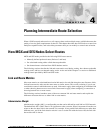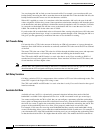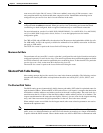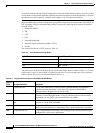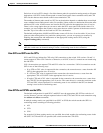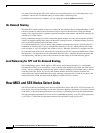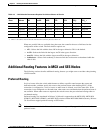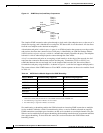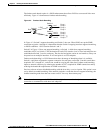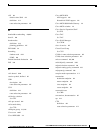
4-9
Cisco PNNI Network Planning Guide for MGX and SES Products, Release 5
Part Number OL-3847-01 Rev. D0, April, 2004
Chapter 4 Planning Intermediate Route Selection
Additional Routing Features in MGX and SES Nodes
The grooming feature can be implemented at any time. Grooming is not configured at the same time as
connections, so there is no penalty if you do not include grooming in the initial plan for a PNNI network.
Soft Rerouting
The soft reroute feature is new in Release 5 and minimizes reroute times by establishing a new
connection before releasing the rerouted connection. This feature requires no prior planning and can be
implemented at any time. For more information, refer to the Cisco MGX 8850 (PXM1E/PXM45), Cisco
MGX 8950, Cisco MGX 8830, and Cisco MGX 8880 Configuration Guide, Release 5.
Priority Bumping
Priority bumping is a new feature in Release 5.0. When enabled, priority bumping can be used to release
lower priority connections to make room for an incoming, higher priority connection.
The priority bumping feature can be implemented at any time. However, the routing priority used for
priority bumping is the same as used for priority routing. Because the routing priority is configured while
creating and configuring connections, you might want to review the priority bumping feature details
before configuring connections and interfaces. You can find more information on priority bumping in
the Cisco MGX 8850 (PXM1E/PXM45), Cisco MGX 8950, Cisco MGX 8830, and Cisco MGX 8880
Configuration Guide, Release 5.
Blocking Pass-Through Connections
As a switch administrator, you can configure MGX and SES nodes to support or deny connections that
pass through the node. If you chose to deny transit or pass-through connections, the node will only accept
calls that terminate on one of the node’s interfaces. Other nodes will not be able to establish routes
through the blocked node to other nodes. This feature is called the Nodal Transit Restriction feature.
Nodal Point-to-Multipoint Branch Restriction
The point-to-multipoint (P2MP) feature enables select Cisco MGX switches to support PNNI network
applications such as data and video broadcast and LAN emulation. P2MP branching is a feature that
allows a switch to accept one incoming connection and produce multiple outgoing connections. This
enables basic P2MP connectivity. For the nodes that support P2MP branching, branching can be enabled
or disabled.
Note Cisco SES equipped BPX switches can serve as the source or destination of a P2MP connection, but
these switches cannot perform branching.
Figure 4-1 shows the data flow in a P2MP connection and introduces the root, leaf, and party terms,
which apply to the interfaces that support P2MP connections.



